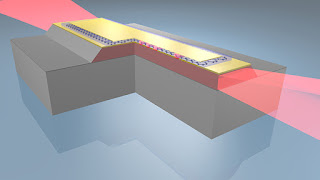 |
| Image source: Technology Review |
Topics: Biology, Biophysics, Electrical Engineering, Electromagnetism, Quantum Mechanics
TECHNOLOGY REVIEW: Physicists have worked out how to measure the magnetic fields generated by single nerves from outside the body and at room temperature.
Biologists have known that nerves produce and respond to electrical signals since the 18th century, when Luigi Galvani discovered that the muscles in a frog’s leg twitch when stimulated by a spark.
However, the systematic study of the electrical signals that nerves produce had to wait until the early 20th century for the development of sensitive electrical recording equipment such as the cathode ray oscilloscope.
This development revolutionized the understanding of nervous function. The ways nerves conduct signals can be a powerful indicator for diseases such as multiple sclerosis and can even detect certain types of intoxication.
And yet the method has some drawbacks. For example, measuring electrical signals in nerves by inserting a needle-like electrode is somewhat invasive, and the mere act of attaching an electrode to a nerve can change the signal, making the results hard to interpret. So neuroscientists have long hoped for a noninvasive technique that could do the job instead.
That may be about to happen thanks to the work of Kasper Jensen at the University of Copenhagen in Denmark and a few pals who have developed a way to easily measure the magnetic fields associated with electrical signals in nerves. The technique could pave the way for a new generation of diagnostic tools for spotting diseases linked to nervous function and for understanding the basic function of nerves.
Physics arXiv:
Non-invasive detection of animal nerve impulses with an atomic magnetometer operating near quantum limited sensitivity
Kasper Jensen, Rima Budvytyte, Rodrigo A. Thomas, Tian Wang, Annette Fuchs, Mikhail V. Balabas, Georgios Vasilakis, Lars Mosgaard, Thomas Heimburg, Søren-Peter Olesen, Eugene S. Polzik


















